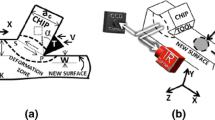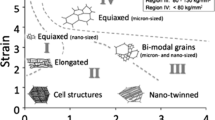Abstract
The evolution of micro-texture below the machined surface is computationally modeled and experimentally verified. The orientation distribution functions of the grains below the surface were represented in spectral form. The microstructure descriptor coefficients were derived, and their change with respect to the change in the cutting feed rate was computationally calculated and monitored. Micro-texture experimental observations conducted by electron back-scatter diffraction technique verify the modeling outputs. Continuation of changing the process parameter was done by finite element method, and the evolution in texture was investigated by computational modeling. The process path function which correlates micro-texture evolution and cutting feed rate, was obtained by applying the principle of orientation conservation in the Euler space. As a result of the major finding of this work, i.e., derivation of process path functions, the evolution of texture as a function of the material feed rate is numerically determined without any need to texture modeling or finite element analyses.







Similar content being viewed by others
References
R. Asthana, A. Kumar, and N.B. Dahotre, Materials Processing and Manufacturing Science, Butterworth-Heinemann, Oxford, 2006
N. Bontcheva and G. Petzov, Microstructure Evolution During Metal Forming Processes, Comput. Mater. Sci., 2003, 28(3), p 563–573
I. Ghamarian et al., A Constitutive Equation Relating Composition and Microstructure to Properties in Ti-6Al-4V: As Derived Using a Novel Integrated Computational Approach, Metall. Mater. Trans. A, 2015, doi:10.1007/s11661-015-3072-4
G. Saheli, H. Garmestani, and B. Adams, Microstructure Design of a Two Phase Composite Using Two-Point Correlation Functions, J. Comput. Aided Mater. Des., 2004, 11(2), p 103–115
D. Li et al., Multiproperty Microstructure and Property Design of Magnetic Materials, J. Eng. Mater. Technol., 2008, 130(2), p 021023
D.T. Fullwood et al., Microstructure Sensitive Design for Performance Optimization, Prog. Mater Sci., 2010, 55(6), p 477–562
S. Tabei et al., Microstructure Reconstruction and Homogenization of Porous Ni-YSZ Composites for Temperature Dependent Properties, J. Power Sources, 2013, 235(1), p 74–80
M. Baniassadi et al., Three-Dimensional Reconstruction and Homogenization of Heterogeneous Materials Using Statistical Correlation Functions and FEM, Comput. Mater. Sci., 2012, 51(1), p 372–379
A. Tabei, S. Ahzi, D.S. Li, C.A. Lavender, and H. Garmestani, Effects of Morphology and Geometry of Inclusions on Two-Point Correlation Statistics in Two Phase Composites, Int. J. Theor. Appl. Multiscale Mech., 2014, 3(1), p 1–17
O. Engler, Texture and Anisotropy in the Al-Mg Alloy AA 5005—Part I: Texture Evolution During Rolling and Recrystallization, Mater. Sci. Eng., A, 2014, 618, p 654–662
T. Li et al., Production of Fine-Grained and Weak Texture Structure in an Mg-7Gd-5Y-1Nd-0.5 Zr Alloy by Multi-Axial Forging, Appl Mech Mater, 2014, 633, p 120–124
F. Kabirian, A.S. Khan, and T. Gnäupel-Herlod, Visco-plastic Modeling of Mechanical Responses and Texture Evolution in Extruded AZ31 Magnesium Alloy for Various Loading Conditions, Int. J. Plast, 2015, 68, p 1–20
S. Shajari, M.H. Sadeghi, and H. Hassanpour, The Influence of Tool Path Strategies on Cutting Force and Surface Texture during Ball End Milling of Low Curvature Convex Surfaces, ScientificWorldJournal, 2014, 2014, p 374526
A. Tabei et al., Analysis of Micro-texture and Grain Size Distributions in Machined Aluminum Alloy 7075, Adv. Mater. Res., 2014, 1052(1), p 489–494
H.J. Bunge and P.R. Morris, Texture Analysis in Materials Science: Mathematical Methods, Butterworths, London, 1982
A. Clement, Prediction of Deformation Texture Using a Physical Principle of Conservation, Mater. Sci. Eng., 1982, 55(2), p 203–210
D.S. Li, J. Bouhattate, and H. Garmestani, Processing Path Model to Describe Texture Evolution During Mechanical Processing, Mater. Sci. Forum, 2005, 495(1), p 977–982
S.G. Epstein, Aluminum and Its Alloys, Aluminum Association, Washington, D.C., 1994
N. Brar, V. Joshi, and B. Harris, Constitutive Model Constants for Al7075-t651 and Al7075-t6. In Shock Compression of Condensed Matter 2009, Proceedings of the American Physical Society Topical Group on Shock Compression of Condensed Matter, 2009, AIP Publishing
S. Lin, H. Garmestani, and B. Adams, The Evolution of Probability Functions in an Inelastically Deforming Two-Phase Medium, Int. J. Solids Struct., 2000, 37(3), p 423–434
H. Garmestani et al., Statistical Continuum Theory for Large Plastic Deformation of Polycrystalline Materials, J. Mech. Phys. Solids, 2001, 49(3), p 589–607
J.D. Eshelby, The Determination of the Elastic Field of an Ellipsoidal Inclusion, and Related Problems, Proc. R. Soc. Lond. A, 1957, 241(1226), p 376–396
A. Molinari, G. Canova, and S. Ahzi, A Self Consistent Approach of the Large Deformation Polycrystal Viscoplasticity, Acta Metall., 1987, 35(12), p 2983–2994
R. Lebensohn and C. Tomé, A Self-Consistent Anisotropic Approach for the Simulation of Plastic Deformation and Texture Development of Polycrystals: Application to Zirconium Alloys, Acta Metall. Mater., 1993, 41(9), p 2611–2624
D. Li, H. Garmestani, and S. Schoenfeld, Evolution of Crystal Orientation Distribution Coefficients During Plastic Deformation, Scr. Mater., 2003, 49(9), p 867–872
S. Ahmadi, B. Adams, and D. Fullwood, An Eulerian-Based Formulation for Studying the Evolution of the Microstructure under Plastic Deformations, Comput. Mater. Contin., 2010, 14(2), p 141–170
D. Li, H. Garmestani, and S. Ahzi, Processing Path Optimization to Achieve Desired Texture in Polycrystalline Materials, Acta Mater., 2007, 55(2), p 647–654
Acknowledgments
The Boeing Company is deeply appreciated for financial support of this project.
Author information
Authors and Affiliations
Corresponding author
Rights and permissions
About this article
Cite this article
Tabei, A., Shih, D.S., Garmestani, H. et al. Derivation of Process Path Functions in Machining of Al Alloy 7075. J. of Materi Eng and Perform 24, 4503–4509 (2015). https://doi.org/10.1007/s11665-015-1706-8
Received:
Revised:
Published:
Issue Date:
DOI: https://doi.org/10.1007/s11665-015-1706-8




